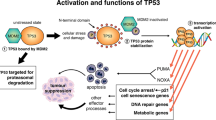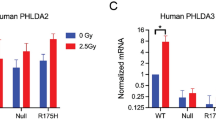Abstract
The tumor suppressor protein, p53 is one of the most important cellular defences against malignant transformation. In response to cellular stressors p53 can induce apoptosis, cell cycle arrest or senescence as well as aid in DNA repair. Which p53 function is required for tumor suppression is unclear. The proline-rich domain (PRD) of p53 (residues 58–101) has been reported to be essential for the induction of apoptosis. To determine the importance of the PRD in tumor suppression in vivo we previously generated a mouse containing a 33-amino-acid deletion (residues 55–88) in p53 (mΔpro). We showed that mΔpro mice are protected from T-cell tumors but not late-onset B-cell tumors. Here, we characterize the functionality of the PRD and show that it is important for mediating the p53 response to DNA damage induced by γ-radiation, but not the p53-mediated responses to Ha-Ras expression or oxidative stress. We conclude that the PRD is important for receiving incoming activating signals. Failure of PRD mutants to respond to the activating signaling produced by DNA damage leads to impaired downstream signaling, accumulation of mutations, which potentially leads to late-onset tumors.
This is a preview of subscription content, access via your institution
Access options
Subscribe to this journal
Receive 50 print issues and online access
$259.00 per year
only $5.18 per issue
Buy this article
- Purchase on Springer Link
- Instant access to full article PDF
Prices may be subject to local taxes which are calculated during checkout








Similar content being viewed by others
References
Lane DP . p53, guardian of the genome. Nature 1992; 358: 15–16.
Hollstein M, Sidransky D, Vogelstein B, Harris CC . P53 Mutations in Human Cancers. Science 1991; 253: 49–53.
Scheffner M, Werness BA, Huibregtse JM, Levine AJ, Howley PM . The E6 oncoprotein encoded by human papillomavirus types 16 and 18 promotes the degradation of p53. Cell 1990; 63: 1129–1136.
Malkin D, Li FP, Strong LC, Fraumeni JF, Nelson CE, Kim DH et al. Germ line p53 mutations in a familial syndrome of breast cancer, sarcomas, and other neoplasms. Science 1990; 250: 1233–1238.
Olive KP, Tuveson DA, Ruhe ZC, Yin B, Willis NA, Bronson RT et al. Mutant p53 gain of function in two mouse models of Li-Fraumeni syndrome. Cell 2004; 119: 847–860.
Lang GA, Iwakuma T, Suh YA, Liu G, Rao VA, Parant JM et al. Gain of function of a p53 hot spot mutation in a mouse model of Li-Fraumeni syndrome. Cell 2004; 119: 861–872.
Jacks T, Remington L, Williams BO, Schmitt EM, Halachmi S, Bronson RT et al. Tumor Spectrum Analysis in P53-Mutant Mice. Curr Biol 1994; 4: 1–7.
Donehower LA, Harvey M, Slagle BL, Mcarthur MJ, Montgomery CA, Butel JS et al. Mice Deficient for P53 Are Developmentally Normal But Susceptible to Spontaneous Tumors. Nature 1992; 356: 215–221.
Haupt Y, Maya R, Kazaz A, Oren M . Mdm2 promotes the rapid degradation of p53. Nature 1997; 387: 296–299.
Braithwaite AW, Royds JA, Jackson P . The p53 story: layers of complexity. Carcinogenesis 2005; 26: 1161–1169.
Vousden KH, Lane DP . p53 in health and disease. Nat Rev Mol Cell Biol 2007; 8: 275–283.
Walker K, Levine A . Identification of a novel p53 functional domain that is necessary for efficient growth suppression. Proc Natl Acad Sci 1996; 93: 15335–15340.
Baptiste N, Friedlander P, Chen XB, Prives C . The proline-rich domain of p53 is required for cooperation with anti-neoplastic agents to promote apoptosis of tumor cells. Oncogene 2002; 21: 9–21.
Venot C, Maratrat M, Dureuil C, Conseiller E, Bracco L, Debussche L . The requirement for the p53 proline-rich functional domain for mediation of apoptosis is correlated with specific PIG3 gene transactivation and with transcriptional repression. EMBO J 1998; 17: 4668–4679.
Edwards SJ, Hananeia L, Eccles MR, Zhang YF, Braithwaite AW . The proline-rich region of mouse p53 influences transactivation and apoptosis but is largely dispensable for these functions. Oncogene 2003; 22: 4517–4523.
Toledo F, Krummel KA, Lee CJ, Liu CW, Rodewald LW, Tang M et al. A mouse p53 mutant lacking the proline-rich domain rescues Mdm4 deficiency and provides insight into the Mdm2-Mdm4-p53 regulatory network. Cancer cell 2006; 9: 273–285.
Slatter TL, Ganesan P, Holzhauer C, Mehta R, Rubio C, Williams G et al. p53-mediated apoptosis prevents the accumulation of progenitor B cells and B-cell tumors. Cell Death Differ 2010; 17: 540–550.
Teodoro JG, Shore GC, Branton PE . Adenovirus E1A Proteins Induce Apoptosis by Both P53-Dependent and P53-Independent Mechanisms. Oncogene 1995; 11: 467–474.
Hansen RS, Braithwaite AW . The growth-inhibitory function of p53 is separable from transactivation, apoptosis and suppression of transformation by E1a and Ras. Oncogene 1996; 13: 995–1007.
Whyte P, Buchkovich KJ, Horowitz JM, Friend SH, Raybuck M, Weinberg RA et al. Association between an oncogene and an anti-oncogene: the adenovirus E1A proteins bind to the retinoblastoma gene product. Nature 1988; 334: 124–129.
Braithwaite AW, Cheetham BF, Li P, Parish CR, Waldronstevens LK, Bellett AJD . Adenovirus-Induced Alterations of the Cell-Growth Cycle - A Requirement for Expression of E1A But Not of E1B. J Virol 1983; 45: 192–199.
Lowe SW, Ruley HE . Stabilization of the P53 Tumor Suppressor Is Induced by Adenovirus-5 E1A and Accompanies Apoptosis. Gene Dev 1993; 7: 535–545.
Parrinello S, Samper E, Krtolica A, Goldstein J, Melov S, Campisi J . Oxygen sensitivity severely limits the replicative lifespan of murine fibroblasts. Nat Cell Biol 2003; 5: 741–747.
Serrano M, Lin AW, McCurrach ME, Beach D, Lowe SW . Oncogenic ras Provokes Premature Cell Senescence Associated with Accumulation of p53 and p16INK4a. Cell 1997; 88: 593–602.
Rogakou EP, Pilch DR, Orr AH, Ivanova VS, Bonner WM . DNA double-stranded breaks induce histone H2AX phosphorylation on serine 139. J Biol Chem 1998; 273: 5858–5868.
Horn PL, Turker MS, Ogburn CE, Disteche CM, Martin GM . A Cloning Assay for 6-Thioguanine Resistance Provides Evidence Against Certain Somatic Mutational Theories of Aging. J Cell Physiol 1984; 121: 309–315.
Sakamuro D, Sabbatini P, White E, Prendergast GC . The polyproline region of p53 is required to activate apoptosis but not growth arrest. Oncogene 1997; 15: 887–898.
Toledo F, Lee CJ, Krummel KA, Rodewald LW, Liu CW, Wahl GM . Mouse mutants reveal that putative protein interaction sites in the p53 proline-rich domain are dispensable for tumor suppression. Mol Cell Biol 2007; 27: 1425–1432.
Hammond EM, Denko NC, Dorie MJ, Abraham RT, Giaccia AJ . Hypoxia links ATR and p53 through replication arrest. Mol Cell Biol 2002; 22: 1834–1843.
Cordenonsi M, Montagner M, Adorno M, Zacchigna L, Martello G, Mamidi A et al. Integration of TGF-+f and Ras/MAPK Signaling Through p53 Phosphorylation. Science 2007; 315: 840–843.
Khanna KK, Keating KE, Kozlov S, Scott S, Gatei M, Hobson K et al. ATM associates with and phosphorylates p53: mapping the region of interaction. Nat Genet 1998; 20: 398–400.
Lee JH, Paull TT . Direct Activation of the ATM Protein Kinase by the Mre11/Rad50/Nbs1 Complex. Science 2004; 304: 93–96.
Deng CX, Zhang PM, Harper JW, Elledge SJ, Leder P . Mice Lacking P21(C/P1/Waf1) Undergo Normal Development, But Are Defective in G1 Checkpoint Control. Cell 1995; 82: 675–684.
Michalak EM, Villunger A, Adams JM, Strasser A . In several cell types tumour suppressor p53 induces apoptosis largely via Puma but Noxa can contribute. Cell Death Differ 2008; 15: 1019–1029.
Salvador JM, Hollander MC, Nguyen AT, Kopp JB, Barisoni L, Moore JK et al. Mice lacking the p53-effector gene Gadd45a develop a Lupus-like syndrome. Immunity 2002; 16: 499–508.
Xu J . Preparation, Culture, and Immortalization of Mouse Embryonic Fibroblasts. John Wiley & Sons Inc., New York, NY, USA, 2001.
Samuelson AV, Lowe SW . Selective induction of p53 and chemosensitivity in RB-deficient cells by E1A mutants unable to bind the RB-related proteins. Proc Natl Acad Sci USA 1997; 94: 12094–12099.
Author information
Authors and Affiliations
Corresponding author
Ethics declarations
Competing interests
The authors declare no conflict of interest.
Additional information
Supplementary Information accompanies the paper on the Oncogene website
Supplementary information
Rights and permissions
About this article
Cite this article
Campbell, H., Mehta, R., Neumann, A. et al. Activation of p53 following ionizing radiation, but not other stressors, is dependent on the proline-rich domain (PRD). Oncogene 32, 827–836 (2013). https://doi.org/10.1038/onc.2012.102
Received:
Revised:
Accepted:
Published:
Issue Date:
DOI: https://doi.org/10.1038/onc.2012.102
Keywords
This article is cited by
-
The proline rich domain of p53 is dispensable for MGMT-dependent DNA repair and cell survival following alkylation damage
Cell Death & Differentiation (2017)
-
Δ122p53, a mouse model of Δ133p53α, enhances the tumor-suppressor activities of an attenuated p53 mutant
Cell Death & Disease (2015)



